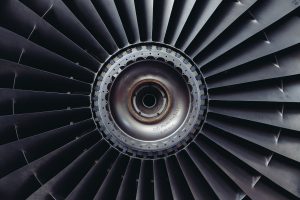Electroless Nickel Plating (ENP) is the autocatalytic chemical reduction of a nickel-alloy (Nickel Phosphorus being the most common) coating used for surface finishing. This process is completed without the electric current that is commonly used in electroplating. ENP is deposited by reducing nickel ions with a chemical reducing agent such as sodium hypophosphite.
The ENP process deposits a very even layer of a Nickel-Phosphorus alloy that typically ranges from 2% to 14% phosphorus. This coating provides several benefits for parts including corrosion resistance, increased hardness, wear resistance, and provides an anti-galling surface. At higher phosphorus content, the coating becomes amorphous, which means that there are no grain boundaries that create initiation sites for corrosion, making it ideal for corrosion protection. However, the higher the phosphorus content in the deposit, the lower the hardness of the deposit. Low phosphorus ENP baths provide the hardest finish with the lowest corrosion protection due to the crystalline nature of the deposit.
What is Electroless Nickel Plating Used For?
Electroless Nickel Plating is versatile and offers many advantages. It is used to keep parts protected from natural wear, abrasion and corrosion, and adds hardness to the surface for all types of applications in varying conditions. Electroless Nickel Plating is most used in the following industries:
- Aerospace
- Construction
- Electronics
- Engineering
- Oil & Gas
Examples of industrial parts that can be finished with ENP include drive shafts, electrical and mechanical tools, engineering equipment, oil field valves, valve pumps and more.
Benefits of Electroless Nickel Plating
The Electroless Nickel Plating process offers various advantages over traditional electroplating that make it a reliable surface finishing treatment:
Corrosion Protection
Electroless Nickel Plating is less porous than electroplated nickel, making it extremely hard and corrosion-resistant to common corrosives such as salt water, carbon dioxide, oxygen, and hydrogen sulfide.
Cost-Effectiveness
Since there is no electricity used to produce the coating itself, it is an efficient and accurate process, thus making it cost-effective for many applications. This strong, high-quality finish can be completed with fewer capital costs than standard electroplating and with less equipment. The finish extends the service life of parts, offering further cost savings on the life of your equipment.
Uniformity
The ENP process deposits a very even coating on parts. Due to the auto-catalytic nature of this process, there are no high-current or low-current areas that lead to over- or under-plating of critical areas of your part. Thickness can be tightly controlled for engineered coatings, which are free from edge build up. Even complex geometries can be evenly coating with this process.
Hardness
There are several different types of ENP baths that contain varying levels of phosphorus: low (2-4%), mid (5-9%), and high (10-14%). The decision as to which bath to use depends on the final application. Low phosphorus EN (2-4%) provides the greatest hardness while providing the lowest corrosion protection, and high phosphorus EN (10-14%) provides the greatest corrosion protection while providing the lowest level of hardness. Many customers opt for the mid-level phosphorus (5-9%), which provides the best of both worlds.
What is the Electroless Nickel Plating Process?
For successful surface treatment, there are certain steps that need to be completed prior to ENP plating. These include the following steps:
- Pretreatment – The surface of the parts is meticulously cleaned with various chemicals to remove residual machining/cooling oils, greases, even fingerprints.
- Surface Activation – After thorough cleaning is completed, the substrate is activated with another chemical such as an acid to remove oxides and activate the surface.
- Plating – After cleaning and activation, parts are placed in the ENP bath for enough time in order to produce the coating thickness required.
- Inspection – After plating, parts that have been coated with ENP are sampled and tested in accordance with specification requirements, or internal standards given no requirements.
Other factors:
- Surface Texture: Uneven metal surfaces such as burrs cannot be effectively plated. All burrs, uneven surfaces, weld spatter, or sharp edges should be removed or smoothed.
- Cleaning: All metal surfaces must be completely clean of dirt, oil, grease, or residue from cleaning processes.
- Surface Activation: ENP plating can be completed on most substrates. It can be applied directly on steel, but other materials may require additional steps to ensure adhesion.
- Plating Baths: ENP baths must be carefully maintained and managed to ensure consistent plating rate, deposit properties, and plating quality. Details such as concentration, temperature, pH and breakdown products must be carefully monitored to ensure a high-quality deposit.
Contact the Plating Experts at Silvex
Silvex, Inc. is proud to be a renowned advanced plating business, trusted by leading manufacturers across New England and throughout the United States for more than 50 years. To learn more about our Electroless Nickel Plating and other finishing services, please contact us today!

